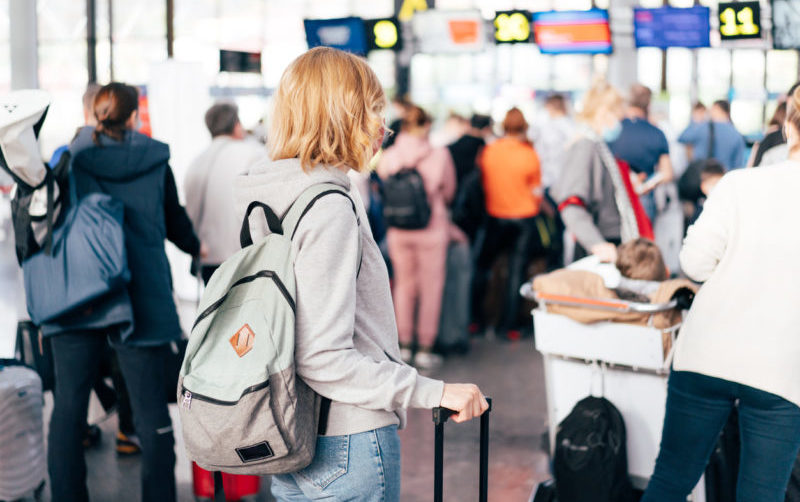Airports are inherently stressful places, and even more so for children with Autism Spectrum Disorder (ASD). There are many steps before getting on the plane and taking off for your favorite destination. To help you prepare for your trip and manage this moment as best as possible, we went to see how things are going in our airports and we took inspiration from the initiatives carried out by our English neighbors, who are well in advance on the issue. Discover our 7 tips for traveling peacefully with an ASD child.

The regulatory framework
In France, and throughout Europe, airports have implemented measures to facilitate access for people with reduced mobility. Indeed, since 2006, they have been subject to European regulations which establish the rules relating to “the protection and assistance for disabled people and people with reduced mobility who travel by air, to protect them against discrimination and ensure that they receive assistance 1 “. But, what about invisible disabilities, and people with autism in particular?
Generally speaking, the main rule for passengers with intellectual or behavioral disabilities (DPNA in airline jargon) is to be accompanied. As a result, assistance services are offered to support passengers.
The example of Nice airport
We contacted Nice Airport’s communications services, who kindly explained to us how the handling of passengers with TSA takes place at their airport:
- The staff responsible for caring for travelers requiring assistance are trained in supporting people with autism, particularly children. An initial discussion with the caregiver is planned to identify the child’s points of attention.
Pick-up is generally done at a PMR (Person with Reduced Mobility) terminal. Depending on the airport, the meeting point can be inside the terminal but also outside, in the parking lot, or at the bus or taxi stop. In Nice, the meeting point is located in the parking lot.
- The person is accompanied at check-in with priority access
- Passage of controls is done in a dedicated line
- Waiting in the departure lounge has moved to a low-population area
- Access to the restroom, before the boarding area, may be considered in the event of a delayed flight.
Our advice
Queues, security checks, announcements, noise, light, and crowds, are all elements that can be distressing for the majority of children with ASD.
Tip #1: Prepare for the trip well in advance
Children with Autism Spectrum Disorder generally have difficulty coping with change. This is why it is important that your child can participate in this event. To help you, there are several tools. For example, use a calendar to allow him to visualize key moments. You can also use pictograms that he can take with him. Watch videos together and explain to him how things will work. You will find a short, quite entertaining video produced by the Union of French Airports: “Airport and passenger journey”. This film, animated and produced in an original format, is composed of illustrations and rare human faces. It can be a good basis for awareness. And if you have the possibility, choose a regional airport, smaller and certainly a little less populated.
Tip #2: Choose the right time
There are busy periods, and the summer holidays are one of them. Avoid reserving your tickets during peak periods as much as possible. Early or late flights are often less crowded. The duration of the flight is also an element to take into account. Try to choose your destination with direct and short flight times. The Time Timer turns out to be a good tool for visualizing and becoming aware of the remaining time. Depending on the age of your child, the watch version of the Time Timer brings a fresh and modern touch and allows self-regulation anywhere and at any time.
Tip #3: Contact Support Services
Generally speaking, a minimum amount of time is required to communicate to the airport the services and needs of the future traveler. It is necessary to contact the airport or airline well in advance, to guarantee care and support adapted to the specific needs of your child. Do not hesitate to prepare your questions in advance and note the particularities specific to your child.
Tip #4: Make your disability visible
Autism is an invisible disability. Therefore, it is important to raise awareness among those around you. You can, for example, take inspiration from the Life Cover, created by Véronique, the mother of a child with autism. Originally, this device was designed for emergency services. A pouch, easy to attach to your bag, which contains essential information (nature of the disability, medical data, precautions to take, contact details, etc.) to help the work of first aiders. But it can find its place if your child is traveling alone, for example.
Tip #5: Organize a visit
Some English airports organize guided tours to help people with ASD familiarize themselves with the environment. So why not consider heading to the nearest airport for a different kind of outing? Wearing headphones or earplugs can be very helpful in protecting you from surrounding noise and avoiding sensory overload. Passing through security gates is more complicated to tackle. You will probably have to cross without a helmet or earplugs. This obligatory passage is often very difficult for children with ASD. You will therefore need to make your child aware of this experience.
Tip #6: Prepare for distraction
Provide something to distract him. Think about activities to do with him, plan fidgets and take objects that reassure him. His favorite stuffed toy, his comfort blanket, and/or his portable games console. Download your favorite movies or programs to a mobile device. He will be able to watch them in queues or during the flight. These little markers will serve to divert your attention from all the surrounding stimuli, before, during, and after the trip. You can also choose to equip yourself with a Sensory bag, which includes noise-canceling headphones, a modeling ball, a tangle, a weighted mat, and a noise fan. A practical solution for peaceful travel.
Tip #7: Allow time
We know that a trip is in preparation! Even if you are very organized, things may not go as planned. A traffic jam on the road, a delayed flight, any incident, and everything can go wrong. So allow enough time to arrive calmly at the airport and to go through all the stages of boarding in peace.
Testimony
Following the publication of our article on social networks, we were able to collect the testimony of Audrey, mother of a 17-year-old teenager. She has used the assistance service several times, for herself, as a person with reduced mobility, and for her son, ADHD. She experienced a minibus service specially reserved for people with specific needs, thus avoiding a restrictive transfer, in the company of all the passengers. Individualized support was put in place and allowed people to get on the plane before everyone else. In the same way, a last exit is organized upon the arrival of the flight. So, do not hesitate to contact the assistance service of the airport or airline with which you wish to travel.


